Half dollar

A half dollar = $0.50
In honor of President ‘John F. Kennedy’ following his 1963 assassination, the ‘Kennedy half dollar’ was originally struck in 1964. Many people associate ‘half dollar’ with the Kennedy design because it’s the most recognizable modern version. However, older half-dollars (pre-1964) are less familiar to the general public but highly collectible.
Since 2002, the U.S. Mint has primarily produced half dollars for “collector sets and numismatic products,” rather than regular circulation. However, the Federal Reserve can still request half dollars for circulation if needed.
| Half dollar | |
|---|---|
| Issue Year | 1794 to Present |
| Composition | Cupro-Nickel (8.33% Ni, Balance Cu) |
| Weight | 11.340 g |
| Diameter | 1.205 inches (30.61 mm) |
| Thickness | 2.15 mm |
| Edge | Reeded* |
| No. of Reeds | 150 |
| Denomination | Half dollar |
| Face value | 50 cents |
| Obverse Inscriptions | “LIBERTY”; “IN GOD WE TRUST”; Year |
| Obverse Sculptor | Gilroy Roberts |
| Reverse Inscriptions | “UNITED STATES OF AMERICA”; “E PLURIBUS UNUM**”; “HALF DOLLAR” |
| Reverse Sculptor | Frank Gasparro |
| Authorizing Law | Coinage Act of April 2, 1792 |
| *Reeded edges (the grooved or ridged edges on coins) were originally designed as a ‘security feature’ to prevent coin ‘clipping or shaving.’ Today, they help ‘deter counterfeiting’ and distinguish coins by feel (e.g., quarters, dimes, and half-dollars all have reeded edges but differ in size and thickness) | |
| **A scroll above the Eagle bears the Latin phrase “E PLURIBUS UNUM” (“Out of many, one”), emphasizing national unity | |
A half dollar is equivalent to “2 quarters, 5 dimes, 10 nickels, or 50 pennies.” The half dollar is the largest U.S. coin by size (30.6mm diameter), larger than ‘quarters or dollar’ coins.
Obverse (heads): Displays President John F. Kennedy’s profile taken from a portrait created for his ‘presidential medal.’
Reverse (tails): Prominently features the Presidential Seal. It consists of an eagle faces left (toward the olive branch), symbolizing a preference for ‘peace over war.’ Olive Branch (right claw): Symbolizes peace. Bundle of 13 Arrows (left claw): Represents ‘strength and readiness’ for war. A shield on the eagle’s chest represents national ‘unity and defense.’ Ring of 50 stars encircles the eagle, signifying the “50 U.S. states.”
The half dollar has three layers of metal covering it. A ‘75 percent copper and 25 percent nickel’ alloy makes up the two identical exterior layers. Copper makes up the inner layer. At least 30% of the coin’s weight is made up of the exterior layers, which are ‘metallurgically’ connected to the inner layer.
History -
| Version | Characteristic(s) |
|---|---|
| Past – 1964 | Made of 90% silver and 10% copper |
| 1965 – 1970 | 40% silver clad (outer layers of copper-nickel bonded to a silver core) |
| 1971 – present | Copper-nickel clad (no silver content), except for special collector editions |
The history of the half dollar dates back to 1794. For over 150 years, the half dollar’s obverse featured a ‘woman’ in a variety of positions, symbolizing liberty. Here’s a summary of those designs:
- Flowing Hair Half Dollar (1794–1795): First U.S. half dollar, featuring ‘Liberty’ with flowing hair (Eagle on the reverse). Designed by Robert Scot.
- Draped Bust Half Dollar (1796–1807): Features Liberty with a draped bust, also designed by Robert Scot.
- Capped Bust Half Dollar (1807–1839): Features Liberty wearing a Phrygian cap (a symbol of freedom) with the word LIBERTY inscribed on the band. Designed by John Reich.
- Seated Liberty Half Dollar (1839–1891): Shows Liberty seated on a rock, holding ‘a shield and a pole’ with a Phrygian cap. Designed by Christian Gobrecht.
- Barber Half Dollar (1892–1915): Features Liberty wearing a ‘cap’ with a laurel wreath.
- Walking Liberty Half Dollar (1916–1947): One of the most iconicS. coin designs, later used for the ‘American Silver Eagle bullion coin’ (since 1986). The obverse depicts Liberty strolling while clutching ‘oak and laurel’ branches in her left hand with her right arm outstretched. In the backdrop, the sun is rising while she is wrapped in the folds of the American flag. Coin reverse depicts an eagle sitting on a rock with its wings spread. Designed by Adolph A. Weinman.
- Franklin Half Dollar (1948–1963): Features ‘Benjamin Franklin’ on the obverse, and the ‘Liberty Bell’ on the reverse. Designed by John R. Sinnock.
- Kennedy Half Dollar (1964–present): Features portrait of President John F. Kennedy on the obverse, and the Presidential Seal on the reverse. A temporary reverse design featuring ‘Independence Hall in Philadelphia’ was used in 1975 and 1976 to celebrate the U.S. Bicentennial (1776–1976). After 1976, the original ‘Presidential Seal’ returned in 1977 (on reverse).
The Mint has struck an estimated 4.1 billion “Kennedy half dollars” since 1964, many of which have made their way into coin collections. In the 1970s, when silver prices were high, many coins ‘dated 1964’ were melted down for their silver content.
The official website of ‘U.S. Mint’ is: https://www.usmint.gov/.
That’s all friends.
Ads Section

